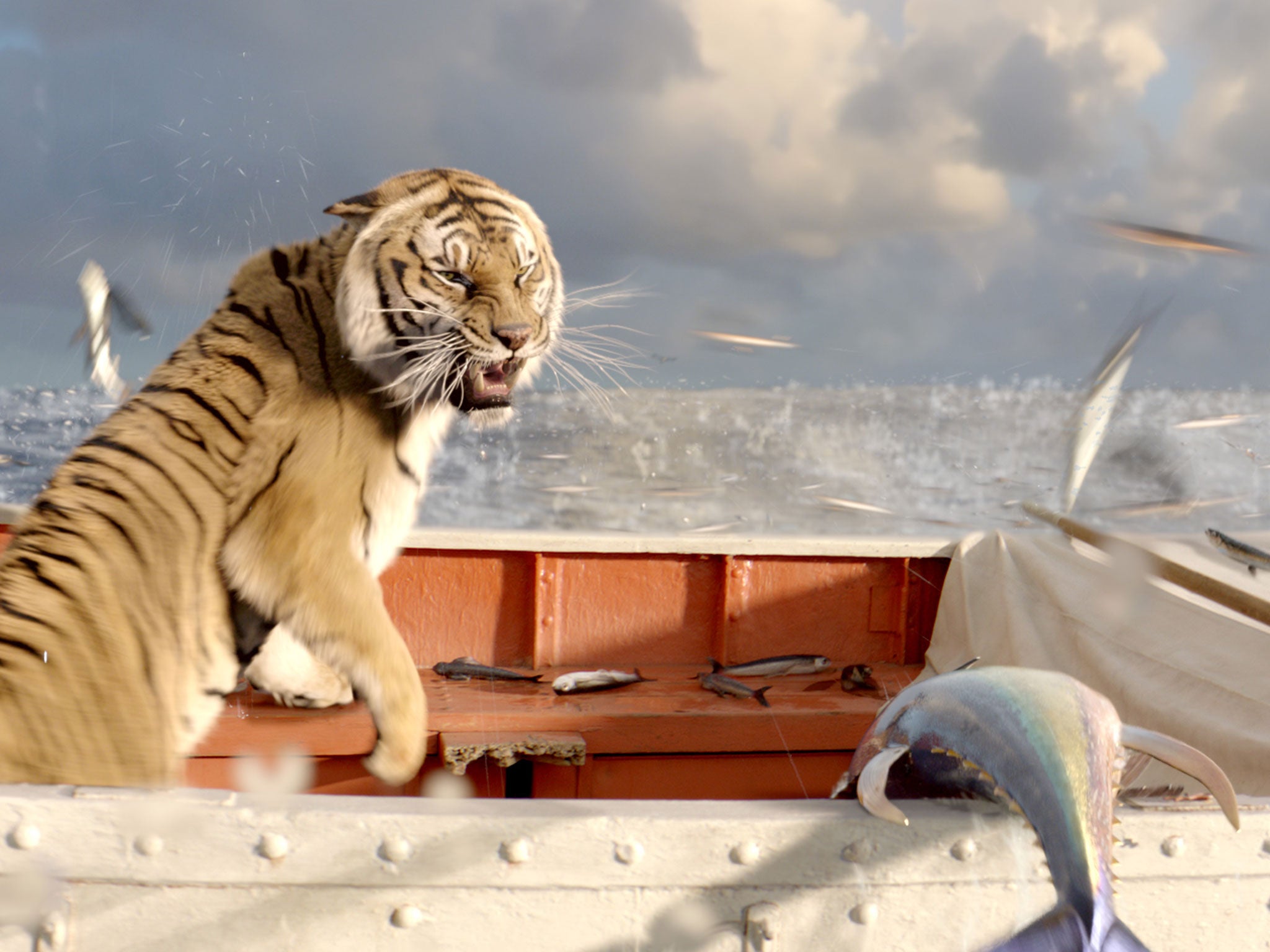IoS film review: Life of Pi
A teenage boy and a ferocious tiger must coexist on a small boat set adrift in a sea of kitsch

Your support helps us to tell the story
From reproductive rights to climate change to Big Tech, The Independent is on the ground when the story is developing. Whether it's investigating the financials of Elon Musk's pro-Trump PAC or producing our latest documentary, 'The A Word', which shines a light on the American women fighting for reproductive rights, we know how important it is to parse out the facts from the messaging.
At such a critical moment in US history, we need reporters on the ground. Your donation allows us to keep sending journalists to speak to both sides of the story.
The Independent is trusted by Americans across the entire political spectrum. And unlike many other quality news outlets, we choose not to lock Americans out of our reporting and analysis with paywalls. We believe quality journalism should be available to everyone, paid for by those who can afford it.
Your support makes all the difference.Audiences often invest a lot of emotion in CGI creations, however obviously artificial. I once gave the thumbs-down to Happy Feet, the computer-animated South Pole musical, resulting in the angriest response I've ever had from a reader: "Mumbles the Penguin saved his community by dancing across Antarctica. What did you ever do – loser?"
I expect people will feel just as passionate about the CGI tiger in Ang Lee's Life of Pi, based on Yann Martel's Man Booker-winning 2001 novel. This remarkable creature unarguably sets a new benchmark for the creation of hyper-real artificial life on screen. Every sinew, every bristling whisker, every mighty lunge is astonishingly detailed, complex, concrete. This beast of luminous pixels is indeed burning bright, and there's no denying the brilliance of its fearsome symmetry, especially in vibrant 3D.
It's not just the tiger that's bigger than life. Lee and his team (notably the cinematographer Claudio Miranda) have devised a coherent overall aesthetic for Martel's fanciful epic. No doubt correctly, Lee has decided that the appropriate keynote is beauty – of a luminous, heightened, sometimes almost abstract nature. But one person's beauty is another's kitsch – and the kitsch, of a glutinous soft-psychedelia intensity, makes Life of Pi as indigestible as it's often extraordinary.
The film recounts the ocean-going ordeal of a teenage boy from Pondicherry, India – Pi, short for Piscine Molitor Patel, named after a Paris swimming pool. That shows the level of whimsy on show – that and the fact that the tiger who becomes Pi's unwitting shipmate is called Richard Parker.
The first half hour is a luminously shot account of Pi's upbringing at his father's zoo, making mercifully brief work of the mercurial digressiveness that is expected from magic realism in literature; in a film, who really cares to know about Uncle Francis, born with too much liquid in his lungs? Mind you, it's here that the film plays some of its nicest 3D tricks, in a retro, Amélie-esque visit to that Paris pool.
We soon reach the story's bizarre core. Emigrating with his family to Canada, Pi survives a terrifying storm at sea and finds himself adrift in a lifeboat in the company of a Bengal tiger, an orang-utan, a hyena and a zebra – it's like the story of Jonah retold with the cast of Madagascar. In its brisk concision, the film squeezes more narrative life from Pi's ordeal than the book does: you don't have to endure long passages about which rope he unknotted when. The meat of the story becomes the extended face-off between boy and beast, told through a series of frenzied manoeuvres on and under tarpaulins.
Along the way, visual highlights include a jellyfish light show, an island teeming with meerkats and a hallucinatory underwater spectacle that is this film's equivalent of the "Stargate" sequence in 2001. The painterly, entirely unnatural beauty sometimes sticks in the throat (how many burnished skies does one film need?), but I accept that the whole point is to go beyond kitsch in search of visual transcendence. Lee identifies the colour of fantasy, and not surprisingly, it's a little garish.
Ultimately, the subject is story; that to spin a yarn is to partake of the divine. That theme emerges in the encounters between Rafe Spall, as a bemused writer, and Irrfan Khan, careworn and contemplative as the adult Pi. His teenage self is played by newcomer Suraj Sharma, who acquits himself extremely well in a preposterously heroic role; cheerfully charismatic, he plays an embodiment of unbowed faith and gets by on suppleness, intelligence and indefatigable good humour.
If you can bear to let your cynicism slip for the odd moment, you might find yourself swept up in the kinetic immersiveness of certain scenes and the illusionistic clarity of others (as in a shot where the boat seems to sail on stars). But as a coherent film experience, one that bears thinking about by adult viewers, Life of Pi is fatally scuppered by coy, bogus mysticism.

Watch Apple TV+ free for 7 days
New subscribers only. £8.99/mo. after free trial. Plan auto-renews until cancelled

Watch Apple TV+ free for 7 days
New subscribers only. £8.99/mo. after free trial. Plan auto-renews until cancelled
Pi is likelife all right, probably more so than any comparable film – yet the more readymade life a film gives you on a plate, the less your imagination creates for itself. "Animals have souls," Pi insists, and the film's bet is to convince us that CGI animals have souls too. Pi's tiger nearly persuaded me – but while it may have a kind of soul, it doesn't have the smell of a tiger, if you know what I mean. For all its magnificence, Life of Pi is a serenely odourless experience.
Join our commenting forum
Join thought-provoking conversations, follow other Independent readers and see their replies
Comments